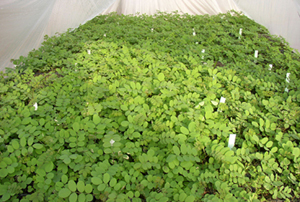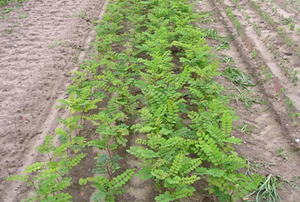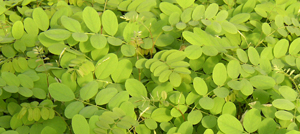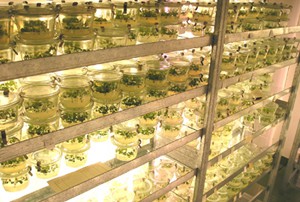Robinia pseudoacacia – Black Locust
Black Locust is well-known as a pioneer tree species and very suitable for the initial forestation of extreme sites. Sparse soil is rooted intensely and ameliorated because of its ability to nitrogen fixation. Due to its adaptability to heat and water stress it is very suitable for new areas of application in times of climate change.
The plant material
At several stands growing straight-boled Black Locust in the Buckow forest district in Märkische Schweiz and in the forest district of Sauen near Beeskow (state of Brandenburg), 33 mother trees approx. 80 years of age with exceptionally straight stem form as well as good breast-height diameter and height parameter have been selected. From these plus trees tissue cultures have been established by the Institute for Forestry Genetics, Location Waldsieversdorf (Thünen-Institut) and transferred to the Institut für Pflanzenkultur in 1999. Conjointly with the Society for Promotion of fastgrowing trees in North Germany e. V. (Gesellschaft zur Förderung schnellwachsender Baumarten in Norddeutschland e.V.) we developed the in vitro culture in such a way to enable the propagation of large quantities by now. The plant material is being tested for approval by the Thünen-Institut according to FoVG.
With special authorisation of the Federal Agency for Agriculture and Food (BLE) at present 24 clones are being propagated and delivered in mixtures of at least 6 clones.
Figure 1: Straight-boled Black Locust mother trees located in the district of Buckow (Märkische Schweiz, Brandenburg) selected for in vitro propagation
Advantages of selected Black Locust clones
As a fast growing tree species Black Locust is appreciated because of its short circulation periods and outstanding quality of wood. The remarkably hard wood is particularly suitable for furniture for outdoor locations e.g. garden furniture. As an alternative to tropical wood it contributes to the concept of environmental protection and sustainable use.
Plant material produced by seed often generates trees of bad stem form. Selected plant material is characterised by excellent growth and particularly straight stem forms. Various clones may as well be inspected at our demonstration plot.

Quality characteristics
The mixture of clones consists of maxiumum 6 Black Locust clones.

During the phase of hardening each Black Locust is being inoculated with nitrogen fixing bacteria (rhizobia) in order to enable proliferation.
Silvicultural information
Black Locust is characterised by its juvenile thriftiness. Its requirement regarding the nutrient supply of soil is very low (like conifers) and due to intense rooting it binds loose sandy soils. It is not to be planted on detritus or coarse-grained sand soils providing a shallow fertile layer because it requires sufficient water until having rooted the soil properly.
Due to its poor ventilation clay soil is not suitable either. Soils providing a mid-deep to deep fertile layer are well suited. Because of the plants high light demand no bottom crop (advance planting) is recommended for existing areas.
Black Locust may be set out in plant spacing 2.5 x 1.25 cm (3,200 plants/ha). The first pruning should be realised as from the second year. The first thinning should be realised after canopy closure.
The pruning of the trees destined for final exploitation is important to increase the quality of timber. The selection of the future plus trees is to be realised at the age of 12-15, whereas the required growing space is to be ensured.
Your planning should arrange for the fostering of 400 to 700 future plus trees/ha.
The stems are to be limbless up to the height of 4-6 m. Only with adequate lighting conditions Black Locust achieves an excellent growth. The light requirement of Black Locust is incrementing as from ages 15-20 years.
When planting, spring drought is to be avoided categorically.
The soil is to be loosened well. Often it is recommended to stump the plants after planting (cutting back of the main shoot to 5 cm above ground).
Further information: Since substandard growth may be removed a mixture with Black Locust seedlings makes sense. In case of closer plant spacing in order to increase its quality even further (stem form, branchiness) this applies as well (as in Hungary).

Information regarding Act on Forest Reproductive Material (Forstvermehrungsgutgesetz FoVG)
Being registered in the list of tree species and artificial hybrids which is subject to directive 199/105/EG (annex to § 2 No 1), Black Locust is subject to FoVG. Currently the Institute for Forest Genetics (Thünen Institut, location Waldsieversdorf) carries out the testing trial necessary for Germany. With special authorisation of the Federal Agency for Agriculture and Food (BLE) demonstration plantations are allowed (only necessary for Germany).
Download: Information Black Locust
